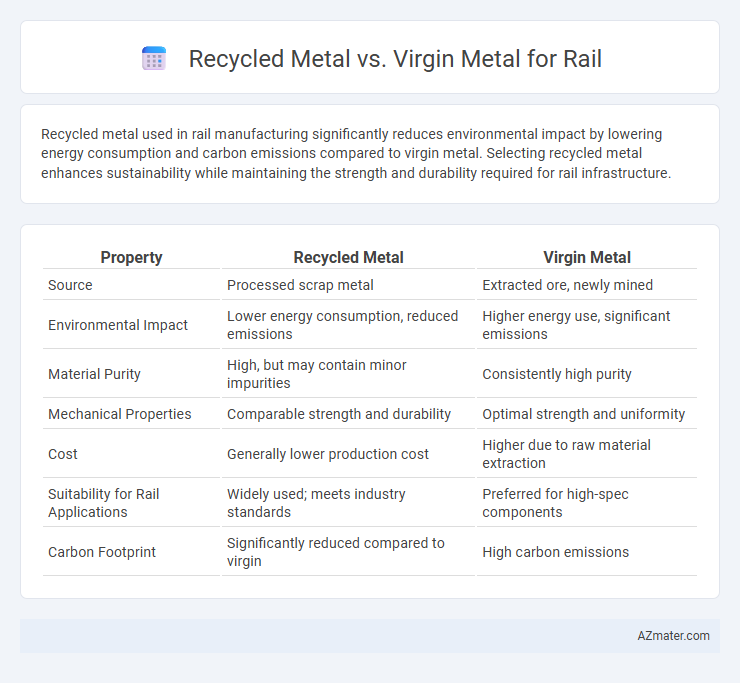Recycled metal used in rail manufacturing significantly reduces environmental impact by lowering energy consumption and carbon emissions compared to virgin metal. Selecting recycled metal enhances sustainability while maintaining the strength and durability required for rail infrastructure.
Table of Comparison
| Property | Recycled Metal | Virgin Metal |
|---|---|---|
| Source | Processed scrap metal | Extracted ore, newly mined |
| Environmental Impact | Lower energy consumption, reduced emissions | Higher energy use, significant emissions |
| Material Purity | High, but may contain minor impurities | Consistently high purity |
| Mechanical Properties | Comparable strength and durability | Optimal strength and uniformity |
| Cost | Generally lower production cost | Higher due to raw material extraction |
| Suitability for Rail Applications | Widely used; meets industry standards | Preferred for high-spec components |
| Carbon Footprint | Significantly reduced compared to virgin | High carbon emissions |
Introduction to Recycled vs Virgin Metal in Rail Industry
Recycled metal in the rail industry significantly reduces environmental impact by lowering the demand for mining virgin metals such as steel and aluminum, which require extensive energy and resources to extract and process. Virgin metals offer high purity and consistent mechanical properties essential for critical rail components, but recycled metals, when properly processed, can achieve comparable strength and durability with substantial cost savings. The growing emphasis on sustainability and circular economy principles drives the rail sector to balance the performance benefits of virgin metals with the ecological advantages of recycled materials.
Environmental Impact: Recycled Metal vs Virgin Metal
Recycled metal for rail production significantly reduces environmental impact by lowering energy consumption by up to 75% compared to virgin metal extraction, which involves intensive mining and refining processes. Utilizing recycled metals decreases greenhouse gas emissions and minimizes habitat destruction, contributing to more sustainable rail infrastructure. The circular use of metals supports resource conservation and reduces landfill waste, making recycled metal the environmentally preferable choice for rail applications.
Cost Comparison: Recycled vs Virgin Rail Metals
Recycled metal for rail manufacturing offers significant cost savings compared to virgin metal due to lower raw material extraction and processing expenses. The energy consumption in producing recycled steel can be up to 75% less than producing virgin steel, directly reducing overall production costs for rail components. While virgin metals provide consistent quality and strength, the economic advantage of recycled metals makes them a preferred choice for sustainable and cost-efficient rail infrastructure projects.
Material Properties and Performance
Recycled metal in rail manufacturing typically maintains comparable mechanical strength and durability to virgin metal, ensuring reliable performance under high stress and dynamic loads. Virgin metals often exhibit superior consistency in purity and microstructure, resulting in enhanced fatigue resistance and longer lifespan for rail components. The choice between recycled and virgin metals balances cost efficiency with performance demands, where recycled metal offers environmental benefits without significantly compromising operational integrity.
Energy Consumption and Emissions
Recycled metal used in rail production significantly reduces energy consumption by up to 75% compared to virgin metal extraction and processing, leading to lower carbon emissions. The emissions associated with recycled metal are substantially minimized, with lifecycle greenhouse gas emissions reduced by approximately 40-60% relative to virgin metal materials. Utilizing recycled metal in rail infrastructure supports sustainable resource management and decreases the overall environmental footprint of the rail industry.
Durability and Longevity for Rail Applications
Recycled metal in rail applications offers comparable durability to virgin metal, maintaining structural integrity through multiple recycling cycles without significant degradation. Virgin metal typically provides higher purity and uniformity, which can enhance longevity in critical rail components exposed to extreme stress and environmental conditions. Both materials undergo stringent testing to ensure compliance with industry standards, but the choice depends on balancing sustainability goals with performance requirements in rail infrastructure.
Availability and Supply Chain Considerations
Recycled metal offers a more sustainable option with a relatively stable availability due to continuous scrap supply, reducing reliance on mining and diminishing environmental impact. Virgin metal supply chains face volatility from mining disruptions, geopolitical issues, and longer lead times, impacting rail manufacturing schedules. Incorporating recycled metal can enhance supply chain resilience while minimizing cost fluctuations in rail infrastructure projects.
Regulatory Standards and Compliance
Recycled metal used in rail manufacturing must meet strict regulatory standards such as ASTM A6 and AREMA specifications, ensuring durability and safety equivalent to virgin metal. Compliance with environmental regulations like the EPA's Resource Conservation and Recovery Act (RCRA) encourages the use of recycled materials, promoting sustainability without compromising structural integrity. Virgin metal, while inherently consistent in quality, often requires higher energy consumption during production, making recycled metal a compliant and eco-efficient alternative for rail infrastructure projects.
Case Studies: Rail Projects Using Recycled Metal
Rail projects utilizing recycled metal demonstrate significant cost savings and environmental benefits compared to virgin metal alternatives. Case studies from European high-speed rail lines revealed that using recycled steel reduced greenhouse gas emissions by up to 40% while maintaining structural integrity and durability. In the United States, transit authorities reported a 25% decrease in procurement costs by incorporating recycled aluminum and steel in railcar components, enhancing sustainability without compromising performance.
Future Trends in Sustainable Rail Metal Sourcing
Recycled metal in rail manufacturing significantly reduces carbon emissions and energy consumption compared to virgin metal, promoting environmental sustainability. Future trends indicate a growing shift toward circular economy practices, with advancements in metal recycling technologies enhancing material quality and durability for rail infrastructure. Increasing regulatory pressure and industry commitments to net-zero goals will drive higher adoption of recycled metals, optimizing resource efficiency and reducing the rail sector's ecological footprint.

Infographic: Recycled metal vs Virgin metal for Rail
 azmater.com
azmater.com